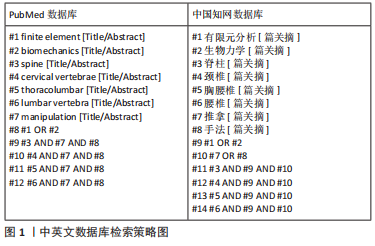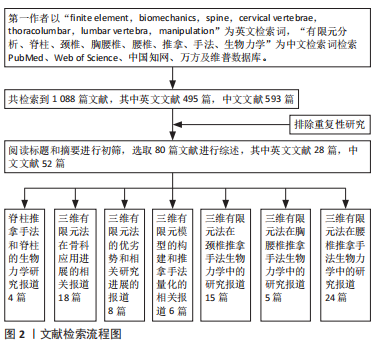[1] 孔博,薛彬,贾友冀,等.传承中不断发展的中医正骨流派现状简析[J].中国中医骨伤科杂志,2016,24(11):70-73.
[2] CASSIDY JD, BRONFORT G, HARTVIGSEN J. Should we abandon cervical spine manipulation for mechanical neck pain? BMJ. 2012;344:e3680.
[3] 梁龙,朱立国,于杰,等.中医手法量化及生物力学研究探析[J].世界中西医结合杂志,2020,15(6):1165-1168.
[4] 郭建鹏,马迅,梁凯恒,等.脊柱颈胸结合部有限元模型的建立[J].临床医药实践,2009,18(1):7-9.
[5] 徐浩翔,文王强,张泽佩,等.腰椎间盘生物力学体内外研究的新进展[J].中国组织工程研究,2020,24(15):2425-2432.
[6] 林松青,王彬,张磊,等.有限元分析在骨科中的应用及研究进展[J].中国中医骨伤科杂志,2013,21(4):69-73.
[7] 宫玉锁,周君,李盛华,等.骨科三维有限元研究进展[J].世界最新医学信息文摘,2019,19(93):40-41, 43.
[8] GALBUSERA F, FANTIGROSSI A, RAIMONDI MT, et al. Biomechanics of the C5-C6 spinal unit before and after placement of a disc prosthesis. Biomechan Model Mechanobiol. 2006;5(4):253-261.
[9] 李斌,赵文志,陈秉智.有限元分析:椎间盘退变对颈椎生物力学的影响[J].中国组织工程研究,2017,21(11):1748-1752.
[10] 秦大平,张晓刚,宋敏.有限元分析在中医正骨手法治疗腰椎疾病作用机制中的应用[J].中国组织工程研究,2012,16(26):4913-4917.
[11] STRANGE DG, FISHER ST, BOUGHTON PC, et al. Restoration of compressive loading properties of lumbar discs with a nucleus implant-a finite element analysis study. Spine J. 2010;10(7): 602-609.
[12] 毕胜,张德文,张明,等.模拟腰部推拿手法三维有限元模型分析[J].军医进修学院学报,2002,23(1):67-69.
[13] 毕胜,张德文,张明,等.腰椎牵引三维有限元模型分析[J].中国康复医学杂志,2002,17(2):20-22.
[14] LIANG L, LIU M, MARTIN C, et al. A deep learning approach to estimate stress distribution: a fast and accurate surrogate of finite-element analysis. J R Soc Interface. 2018;15(138):20170844.
[15] COURANT R. Variational methods for the solution of problems of equilibrium and vibrations. Bull. 1943;49(1):1-24.
[16] WELCH-PHILLIPS A, GIBBONS D, AHERN DP, et al. What is finite element analysis? Clin Spine Surg. 2020;33(8):323-324.
[17] CLOUGH RW. The finite element in plane stress analysis. Proc Asce Conferon Electric Computation, 1960.
[18] BREKELMANS WA, POORT HW, SLOOFF TJ. A new method to analyse the mechanical behaviour of skeletal parts. Acta Orthop Scand. 1972; 43(5):301-317.
[19] SCHULTZ AB, BELYTSCHKO TB, ANDRIACCHI TP, et al. Analog studies of forces in the human spine: mechanical properties and motion segment behavior. J Biomech. 1973;6(4):373-383.
[20] LIU YK, RAY G, HIRSCH C. The resistance of the lumbar spine to direct shear. Orthop Clin North Am. 1975;6(1):33-49.
[21] SIMON BR, WU JS, CARLTON MW, et al. Structural models for human spinal motion segments based on a poroelastic view of the intervertebral disk. J Biomechan Eng. 1985;107(4):327-335.
[22] RAO AA, DUMAS GA. Influence of material properties on the mechanical behaviour of the L5-S1 intervertebral disc in compression: a nonlinear finite element study. J Biomechan Eng. 1991;13(2):139-151.
[23] SHIRAZI-ADL A. Nonlinear stress analysis of the whole lumbar spine in torsion--mechanics of facet articulation. J Biomechan. 1994;27(3): 289-299.
[24] 彭春政,张胜年,陆爱云.人体躯干骨骼-肌肉-韧带结构三维有限元模型的建立和验证[J].中国运动医学杂志,2010,29(6):702-705.
[25] LIN W, MA X, DENG D, et al. Hemodynamics in the circle of willis with internal carotid artery stenosis under cervical rotatory manipulation: a finite element analysis. Med Sci Monit. 2015;21:1820-1826.
[26] SHU XN, MU WZ, CHEN JF, et al. Comparison of biomechanical effect between oblique Ban-pulling manipulation and lumbar erection-rotation manipulation in sitting position for lumbar intervertebral disc herniation. Zhenjiu Tuita Yixue (Yingwenban). 2017;15(5):317-321.
[27] XUE F, CHEN Z, YANG H, et al. Effects of cervical rotatory manipulation on the cervical spinal cord: a finite element study. J Orthop Surg Res. 2021;16(1):737.
[28] 曾雪玲,张帆,王芳莉.有限元分析技术在腰椎推拿手法生物力学中的应用现状[J].西部中医药,2022,35(5):157-161.
[29] 文毅,苏峰,刘肃,等.L4-5椎体有限元模型建立及退变椎间盘力学分析[J].中国组织工程研究,2019,23(8):1222-1227.
[30] 刘建辉,朱建忠,潘福勤,等.不同体位下推拿旋转手法对颈椎间盘有限元模型应力分布的影响[J].世界中西医结合杂志,2020, 15(7):1304-1307.
[31] 刘建辉, 朱建忠,潘福勤,等.颈椎间盘有限元模型分析旋转手法髓核受力与体位的关系[J].内蒙古医科大学学报,2020,42(2):173-175,204.
[32] 周鑫,朱清广,孔令军,等.推拿手法生物力学研究方法的基本方向[J].中华中医药杂志,2019,34(3):1120-1123.
[33] 王辉昊,范鑫,邓真,等.中医整骨手法对颈椎间孔减压术(PECD)后模型的有限元分析[J].医用生物力学, 2021, 36(S1):225.
[34] 王辉昊,詹红生,张明才,等.手法治疗颈椎病意外事件分析与预防策略思考[J].中国骨伤,2012,25(9):730-736.
[35] 邓真,牛文鑫,王辉昊,等.生物力学在中医骨伤手法治疗颈椎病中的应用[J].医用生物力学,2015,30(6):569-573.
[36] 万磊,陈静,李义凯.颈椎定点旋转手法“点”的三维空间解剖位置的研究[J].南方医科大学学报,2008,28(4):548-550, 554.
[37] DENG Z, WANG K, WANG H, et al. A finite element study of traditional Chinese cervical manipulation. Eur Spine J. 2017;26(9):2308-2317.
[38] 黄学成,叶林强,梁德,等.三维有限元模型分析旋转手法中旋转方向对颈椎间盘位移和椎间孔容积的影响[J].中国组织工程研究, 2018,22(3):404-408.
[39] HUANG X, YE L, WU Z, et al. Biomechanical effects of lateral bending position on performing cervical spinal manipulation for cervical disc herniation: a three-dimensional finite element analysis. Evid Based Complement Alternat Med. 2018;2018:2798396.
[40] 黄学成,叶林强,江晓兵,等.不同体位下颈椎旋转手法对颈椎间盘位移和内在应力的影响[J].中国康复理论与实践,2017,23(12): 1470-1475.
[41] 陈奕历, 劳永华, 张少群,等.颈动脉粥样硬化的流体力学模型:旋转手法下颈动脉粥样硬化斑块的血流动力学变化[J].中国组织工程研究,2019,23(15):2403-2408.
[42] 李勇,张泽胜,王伶俐,等.不同牵引角度治疗颈椎病的三维有限元分析研究[J].新中医,2008,40(9):63-64.
[43] 王宇,雷建银,辛浩,等.椎间盘退变颈椎(C2-C7)在正常承载与推拿下的有限元分析[J].中国组织工程研究,2020,24(27):4278-4284.
[44] 邬黎平.颈椎推拿的作用机理及优化研究[D].广州:南方医科大学, 2010.
[45] WU LP, HUANG YQ, MANAS D, et al. Real-time monitoring of stresses and displacements in cervical nuclei pulposi during cervical spine manipulation: a finite element model analysis. J Manipulative Physiol Ther. 2014;37(8):561-568.
[46] 孙国栋,师彬,王丹丹,等.手势动作捕捉技术及有限元分析在神经根型颈椎病三维正脊手法机制研究中的应用分析[J].四川医学, 2018,39(2):223-225.
[47] CAO SN, WANG DD, WANG CA, et al. Finite element analysis of the treatment of cervical spondylotic radiculopathy with three dimensional balanced manipulation. Zhongguo Gu Shang. 2020;33(9):867-872.
[48] CAO S, CHEN Y, ZHANG F, et al. Clinical efficacy and safety of “three-dimensional balanced manipulation” in the treatment of cervical spondylotic radiculopathy by finite element analysis. BioMed Res Int. 2021;2021:5563296.
[49] PEDRAM H, REZA ZM, REZA RM, et al. Spinal fractures resulting from traumatic injuries. Chin J Traumatol. 2010;13(1):3-9.
[50] ZHANG D, WU H, WANG X. Comparative study of the clinical effect and safety of anterior surgical approach and posterior surgical approach in the treatment of thoracolumbar spinal fracture. Open Med. 2015; 10(1):410-415.
[51] 刘迎军,李孝林.有限元分析过伸复位治疗胸腰椎压缩性骨折的椎间盘动态力学[J].中国组织工程研究与临床康复,2011,15(4):589-592.
[52] 舒先涛,李孝林.胸腰椎压缩性骨折患者过伸复位过程中前纵韧带动态力学的有限元分析[J].中国组织工程研究与临床康复,2009, 13(48):9567-9956.
[53] 任伯绪,李孝林.过伸复位治疗胸腰椎压缩性骨折关节突关节动态力学有限元分析[J].山东医药,2010,50(14):4-5.
[54] 韩雪,韩磊,张军,等.冯氏坐位脊柱定点旋转法与中医传统侧卧不定点斜扳法治疗腰椎间盘突出症比较研究[J].北京中医药,2015, 34(8):598-602.
[55] 张慧.腰椎坐位旋转手法治疗非特异性下腰痛的临床疗效观察及腰椎有限元初步探讨[D].北京:中国中医科学院,2015.
[56] 徐海涛,徐达传,李云贵,等.坐位旋转手法时退变腰椎间盘内在应力和位移的有限元分析[J].中国康复医学杂志,2007,22(9):769-771,867.
[57] 徐海涛, 张美超, 徐达传,等.三种前屈角度下坐位旋转手法对腰椎间盘作用的有限元分析[J].中国疗养医学,2008,17(2):65-67.
[58] HU H, XIONG CY, HAN GW. Finite element analysis of lumbar pelvic and proximal femur model with simulate lumbar rotatory manipulation. Zhongguo Gu Shang. 2012;25(7):582-586.
[59] 陈忻,于杰,冯敏山,等.坐位旋转手法治疗退行性腰椎滑脱的椎间盘力学分析[J].中华中医药杂志,2019,34(4):1395-1400.
[60] 陈金凤,舒新农,唐树杰,等.腰椎退变对坐位腰椎定点旋转手法疗效影响的有限元分析(英文)[J]. 针灸推拿医学(英文版),2016, 14(4):295-299.
[61] ZHANG R, MO Z, LI D, et al. Biomechanical comparison of lumbar fixed-point oblique pulling manipulation and traditional oblique pulling manipulation in treating lumbar intervertebral disk protrusion. J Manipulative Physiol Ther. 2020;43(5):446-456.
[62] LI L, SHEN T, LI YK. A Finite element analysis of stress distribution and disk displacement in response to lumbar rotation manipulation in the sitting and side-lying positions. J Manipulative Physiol Ther. 2017;40(8):580-586.
[63] 张人文,莫灼锚,常敏敏,等.坐位定点旋转手法与斜扳手法治疗腰椎间盘突出症的系统评价[J].中医正骨,2018,30(12):30-36.
[64] MO Z, ZHANG R, CHEN J, et al. Comparison between oblique pulling spinal manipulation and other treatments for lumbar disc herniation: a systematic review and meta-analysis. J Manipulative Physiol Ther. 2018;41(9):771-779.
[65] 毕胜,李义凯,赵卫东,等.腰部推拿手法生物力学和有限元比较研究[J].中华物理医学与康复杂志,2002,24(9):16-19.
[66] 徐海涛,李松,刘澜,等.腰椎斜扳手法时椎间盘的有限元分析[J].中国组织工程研究与临床康复,2011,15(13):2335-2338.
[67] 卢钰,郑太才,王琪,等.不同体位下斜扳手法治疗腰椎间盘突出的三维有限元分析[J].中国组织工程研究,2021,25(36):5872-5877.
[68] 贾龙,张华,宋敏,等.“三步三位九法”治疗腰椎间盘突出症临床经验总结[J].世界最新医学信息文摘,2017,17(A2):185-187.
[69] 李延红,张晓刚,李具宝,等.腰椎拔伸手法三维有限元模型分析[J].浙江中医杂志,2010,45(12):879-880.
[70] 杨学锋,张晓刚,李具宝,等.模拟拔伸按压手法腰椎运动节段三维有限元模型分析[J].中国中医骨伤科杂志,2013,21(7):4-6.
[71] 张晓刚,秦大平,宋敏,等.拔伸按压手法对退变腰椎节段应力分布影响的有限元分析[J].中华中医药杂志,2013,28(10):3108-3114.
[72] 尚永,张人文,莫灼锚,等.腰椎退变影响拔伸按压手法生物力学作用的有限元研究[J].山东中医药大学学报,2019,43(2):151-154.
[73] 吕立江,冯喆,廖胜辉,等.杠杆定位手法对腰椎间盘影响的有限元分析[J].中华中医药学刊,2014,32(5):971-973.
[74] 张仁倩,赵志恒,王剑歌,等.三小定点整脊法对腰椎间盘突出症的有限元分析[J].湖南中医杂志,2014,30(8):90-92.
[75] 罗建,金龙,徐侥,等.三维有限元模型下的踩跷法时效性研究[J].四川中医,2017,5(9):148-151.
[76] 李雁婷,陈剑,刘梦兰,等.倒盖金被手法在腰椎间盘生物力学中的三维有限元分析[J].中国组织工程研究,2022,26(3):356-259.
[77] DING H, LIAO L, YAN P, et al. Three-dimensional finite element analysis of l4-5 degenerative lumbar disc traction under different pushing heights. J Healthc Eng. 2021;2021:1322397.
[78] 胡华,熊昌源,韩国武.模拟腰部推拿手法建立“腰-盆-髋”有限元模型[J].中国组织工程研究与临床康复,2011,15(48):8935-8938.
[79] 汪芳俊,魏威,廖胜辉,等.前屈位不同角度牵引治疗颈椎病的有限元分析[J].中国骨伤,2014,27(7):592-596.
[80] 张人文,莫灼锚,李冬,等.二步加载分步求解在手法治疗腰椎间盘突出症有限元分析中的应用[J].中国中医骨伤科杂志,2019, 27(1):1-5. |
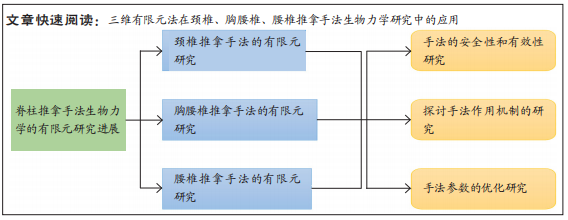
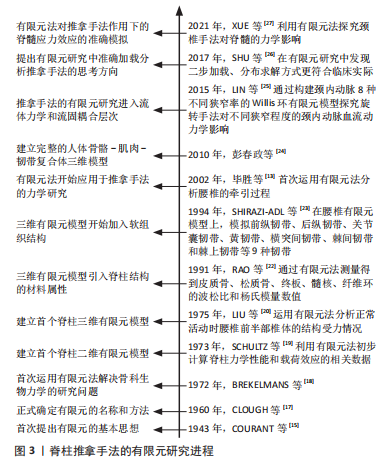
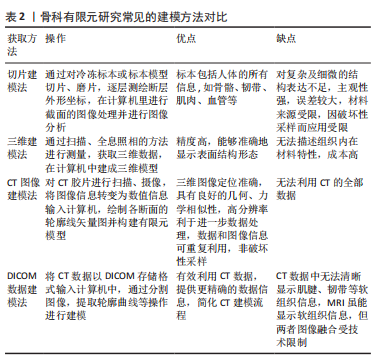
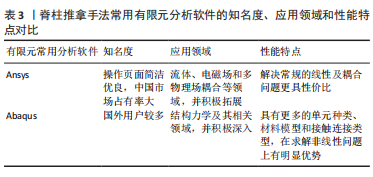
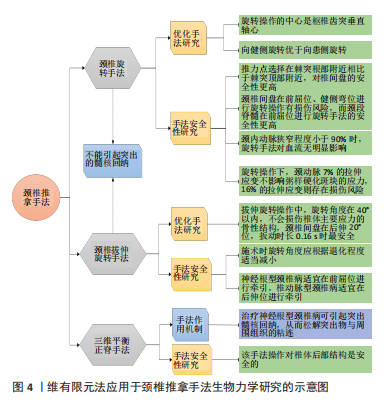
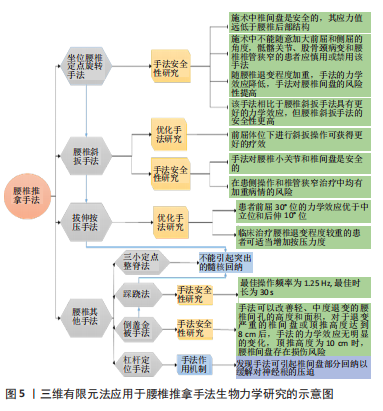

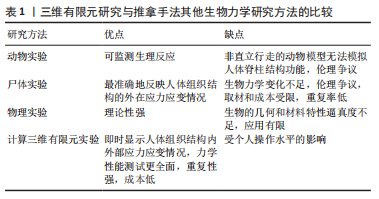 自2002年毕胜等[13]首次运用三维有限元法分析腰椎的牵引过程以来,越来越多的手法学者开始尝试对推拿手法的生物力学问题进行有限元分析,挖掘研究了诸多常见的脊柱推拿手法,其中主要的探究方向集中在颈椎、胸腰椎、腰椎推拿手法的作用机制、安全性和有效性的探讨以及手法操作的优化3个方面。文章就三维有限元法对颈椎、胸腰椎和腰椎推拿手法生物力学研究进行综述,以期为临床更好地应用推拿手法治疗脊柱疾病提供可靠依据。
自2002年毕胜等[13]首次运用三维有限元法分析腰椎的牵引过程以来,越来越多的手法学者开始尝试对推拿手法的生物力学问题进行有限元分析,挖掘研究了诸多常见的脊柱推拿手法,其中主要的探究方向集中在颈椎、胸腰椎、腰椎推拿手法的作用机制、安全性和有效性的探讨以及手法操作的优化3个方面。文章就三维有限元法对颈椎、胸腰椎和腰椎推拿手法生物力学研究进行综述,以期为临床更好地应用推拿手法治疗脊柱疾病提供可靠依据。
